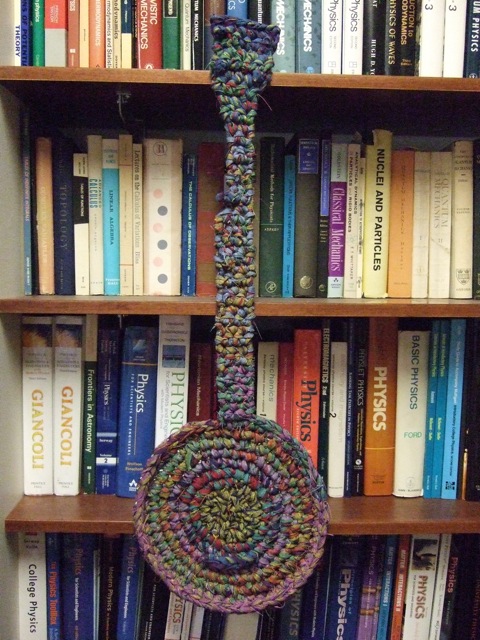 Banjo Physics 411 AND Resonator Guitar Physics 412
Banjo Physics 411 AND Resonator Guitar Physics 412 Banjo Physics 411 AND Resonator Guitar Physics 412
Banjo Physics 411 AND Resonator Guitar Physics 412by David Politzer
Prompted by some success at understanding how some drumhead physics can account for the biggest differences in sound between banjos and guitars, I thought I'd take on resonator guitar physics -- different but in some ways similar.
 Bluesmen weren't the only street musicians eager to embrace something louder. The photo is on the steps of Pasadena City Hall, 1929. Douglas Fairbanks' The Mark of Zorro was released in 1930. He had an estate in Pasadena, then as now a hotbed of ersatz "Spanish Colonial" style.
Bluesmen weren't the only street musicians eager to embrace something louder. The photo is on the steps of Pasadena City Hall, 1929. Douglas Fairbanks' The Mark of Zorro was released in 1930. He had an estate in Pasadena, then as now a hotbed of ersatz "Spanish Colonial" style.
The banjo clearly has many features in common with other stringed instruments. It certainly has plenty of unique features, beloved of players and luthiers, alike. And the physics of much of this is well-understood. This would be the content of "Banjo Physics 101." E.g., what determines the pitch of a plucked string? If you're curious about that, you'll have to look elsewhere. What I hope to do here is report on my research efforts to explore issues of banjo acoustics, banjo construction, banjo mechanics, and banjo science more generally, addressing things I don't understand but believe I could. Why does a banjo sound different from a guitar? Or, even more to the point, why does one banjo sound different from another?
There are always some projects in the works. So, if you find anything here of interest, you might want to check back to see what's new since. If there's something that was of interest, check whether there's anything more recent on the same subject. Some issues have been clarified or expanded. There are even errors that have been corrected in later papers. The most egregious was also the most cited in the popular press -- sort of a man-bite-dog thing.
Here is something S.S. Stewart wrote about professional acousticians of musical instruments. It's as true and relevant today as it was then and may well be the most credible thing on this page.
...and from the back cover of Pete Seeger's banjo instruction treasure: ".........can I read notes? Hell, there are no notes to a banjo. You just play it." -- Reply made by an old-time banjo picker, interviewed around 1850, and asked if he could read music.
You could well argue there are no equations either. On the other hand, I can play banjo in my office; when someone walks by, I just say, "I'm working."
 Having identified what aspect of the sound in terms of spectra and spectrograms sets resonator guitars as a group apart from regular acoustic guitars, I wanted to know what aspect of the resonators is responsible for that common behavior. Duh! Clearly it must be something that they all have in common, and I already showed that it's not aluminum cones or cones made of anything. Wood-body resonators from the very start showed it's not the metal bodies. Basically, it's the same thing that makes them loud. This is explained and demonstrated conclusively by a fiendishly clever experiment, all to be found in Inharmonic Partials of the Resonator Guitar
Having identified what aspect of the sound in terms of spectra and spectrograms sets resonator guitars as a group apart from regular acoustic guitars, I wanted to know what aspect of the resonators is responsible for that common behavior. Duh! Clearly it must be something that they all have in common, and I already showed that it's not aluminum cones or cones made of anything. Wood-body resonators from the very start showed it's not the metal bodies. Basically, it's the same thing that makes them loud. This is explained and demonstrated conclusively by a fiendishly clever experiment, all to be found in Inharmonic Partials of the Resonator Guitar

 Supplementary Recordings of Banjo and Resonator Guitar has two sound files which complement the previous discussions of resonator guitar cone alternatives and sources of banjo inharmonic partials.
Supplementary Recordings of Banjo and Resonator Guitar has two sound files which complement the previous discussions of resonator guitar cone alternatives and sources of banjo inharmonic partials.
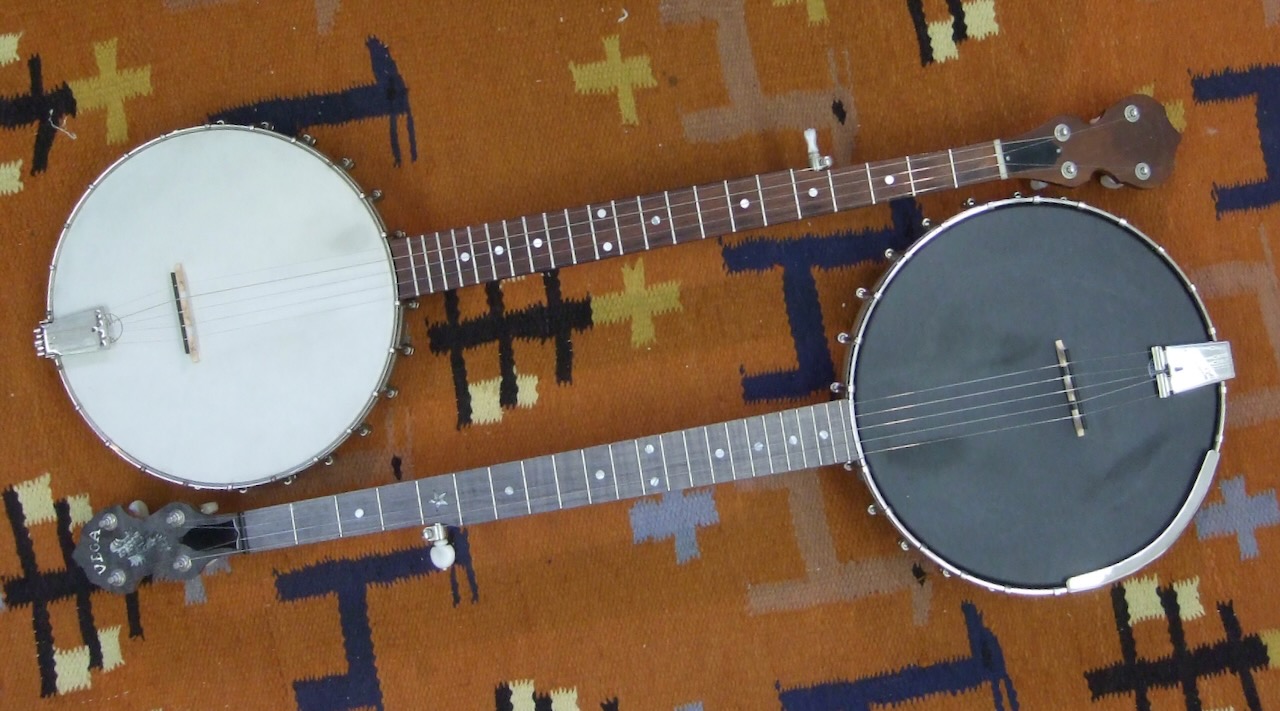 Inharmonic Partials and Banjo Ring identifies unequivocally the physical origins of inharmonic partials in banjo sound. "Partials" are identifiable frequency components of a sound. And "harmonic partials" are essential aspects of musical sound. Specifically, harmonic partials occur with integer multiples of a particular pitch's frequency. Steady notes contain harmonic partials. Plucked string sounds that die away sound "musical" if their partials are harmonic. But that need not be the case. Banjos stand out among string instruments as producing sounds with significant inharmonic content. And it's now quite clear how that arises.
Inharmonic Partials and Banjo Ring identifies unequivocally the physical origins of inharmonic partials in banjo sound. "Partials" are identifiable frequency components of a sound. And "harmonic partials" are essential aspects of musical sound. Specifically, harmonic partials occur with integer multiples of a particular pitch's frequency. Steady notes contain harmonic partials. Plucked string sounds that die away sound "musical" if their partials are harmonic. But that need not be the case. Banjos stand out among string instruments as producing sounds with significant inharmonic content. And it's now quite clear how that arises.
This becomes particularly interesting with the assertion that the reason banjos have been said to "ring" for over 175 years is the presence of those inharmonic partials. Identifiably "metallic" sounds certainly have substantial inharmonic content. In the resonator guitar entries below, starting in April 2023, resonator guitars are shown to differ from regular acoustic guitars by their inharmonic partials. The September 2023 entry isolates just those partials, by themselves. They sound rather like a gong. Inharmonic Partials and Banjo Ring isolates the inharmonic part of banjo sound. It's somewhat peculiar, but at least the physical mechanism responsible for its origin is now clear.
Is that strong inharmonic content responsible for the Ring of the Banjo? I think so. Or is Ring the Banjo! just a figure of speech???
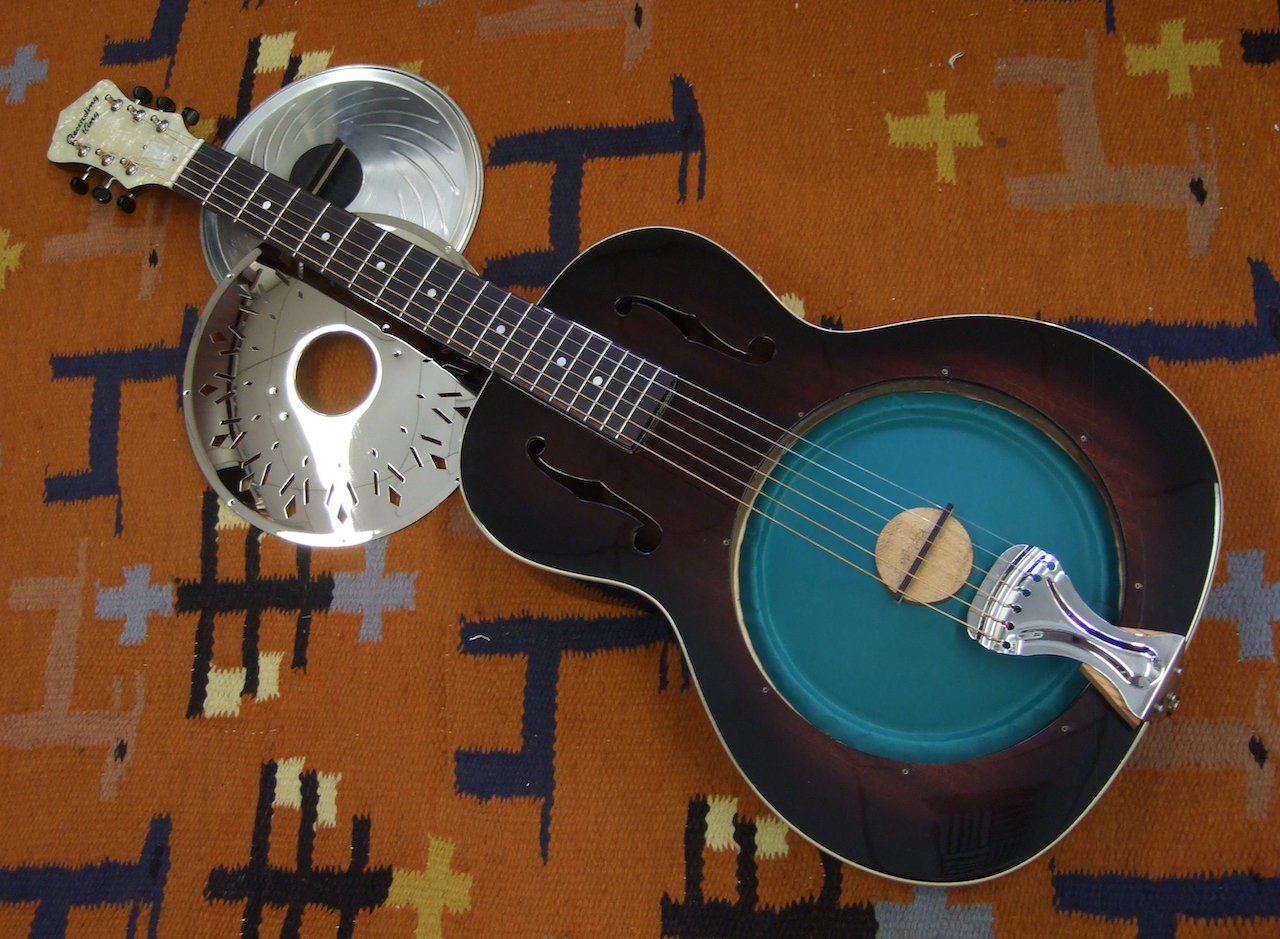 The July 2023 post below, Resonator Guitar Physics Clue from a Paper Cone, identified spectrogram features that are common to resonator guitars and absent from flat-top acoustic guitars. Sound of the Wood-body Resonator Guitar demonstrates that these same sort of features are, indeed, present on wood-body resonator guitars. It's no surprise. They twang, too.
The July 2023 post below, Resonator Guitar Physics Clue from a Paper Cone, identified spectrogram features that are common to resonator guitars and absent from flat-top acoustic guitars. Sound of the Wood-body Resonator Guitar demonstrates that these same sort of features are, indeed, present on wood-body resonator guitars. It's no surprise. They twang, too.
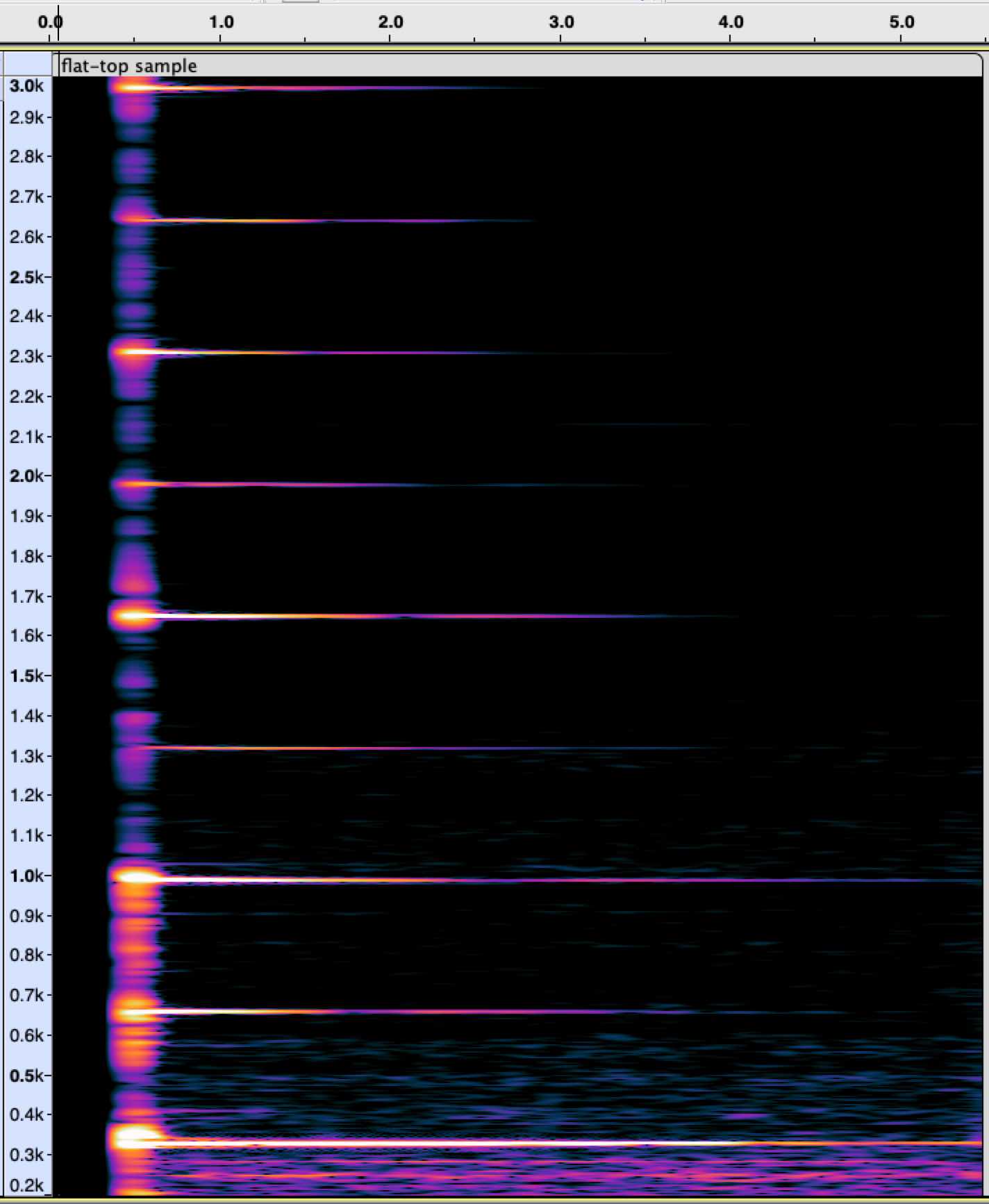
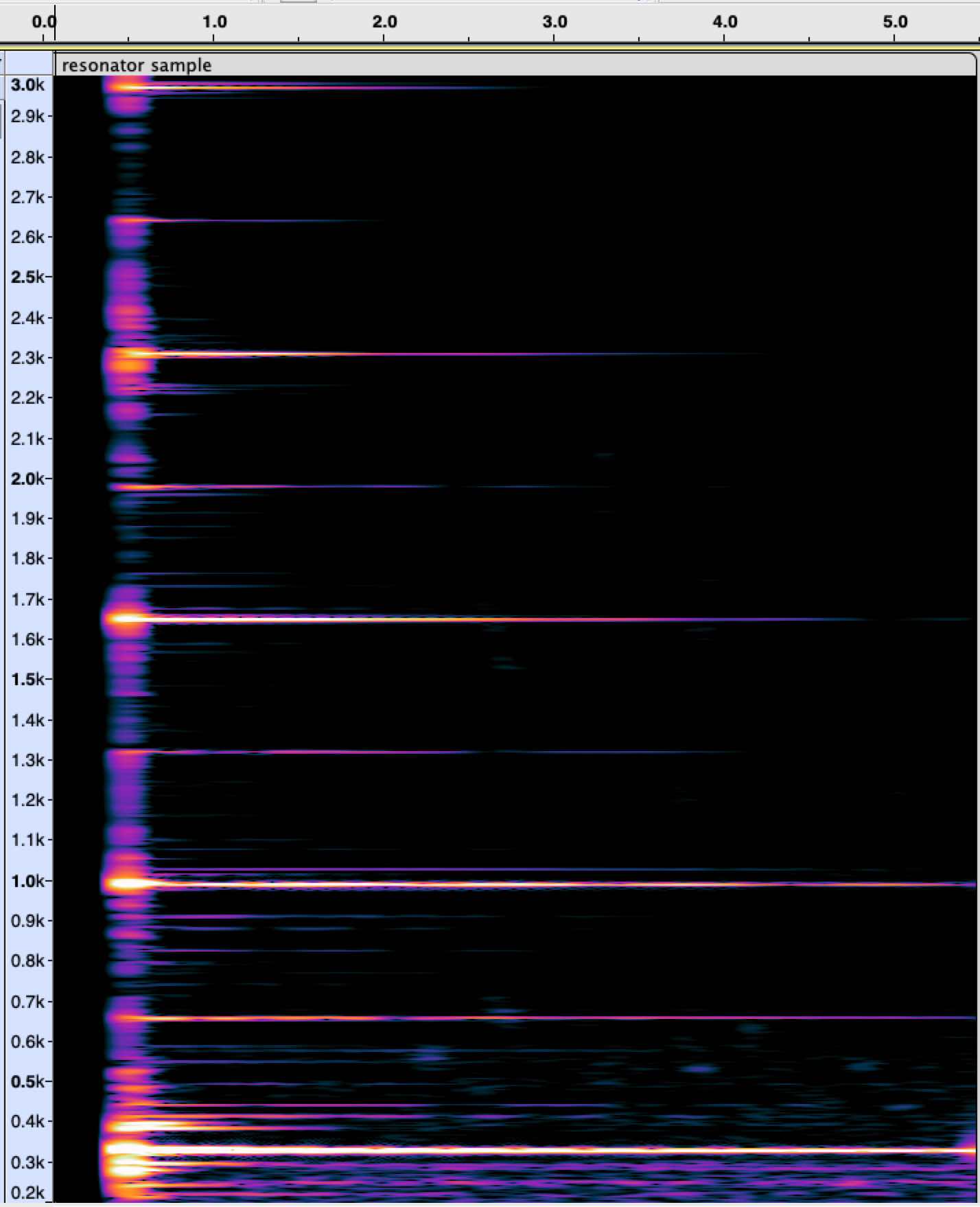
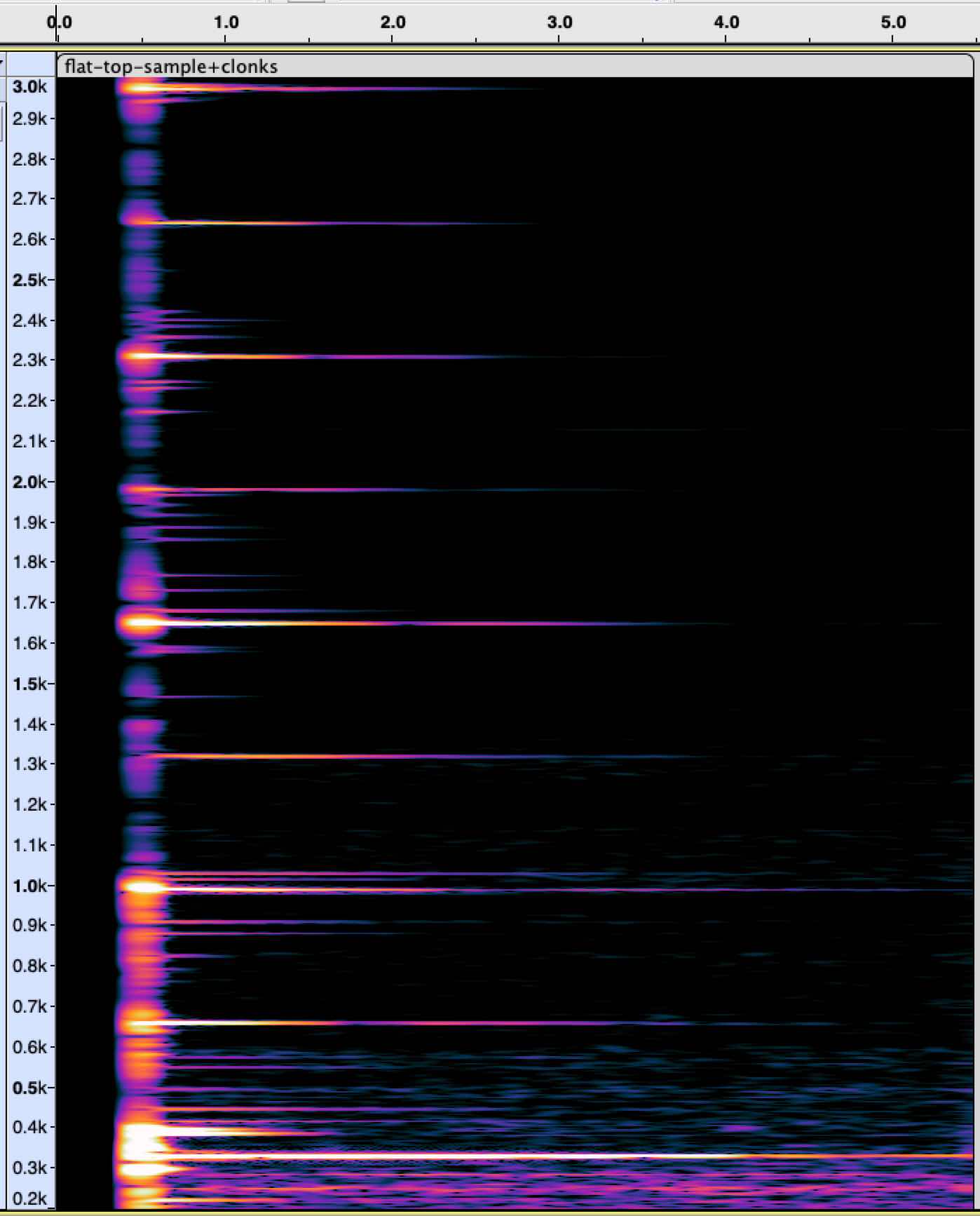 The July 2023 post below, Resonator Guitar Physics Clue from a Paper Cone, identified spectrogram features that are common to resonator guitars and absent from flat-top acoustic guitars. Resonator Guitar Synthesis demonstrates that these features are, indeed, responsible for the characteristic sound that distinguishes resonator guitars. Adding just a handful of pure, sinusoidal tones with frequencies, amplitudes, and decay times to match the resonator spectrogram "extra" features to flat-top guitar sound produces something whose sound is unmistakably resonator guitar. Just listen to the linked sound files.
The July 2023 post below, Resonator Guitar Physics Clue from a Paper Cone, identified spectrogram features that are common to resonator guitars and absent from flat-top acoustic guitars. Resonator Guitar Synthesis demonstrates that these features are, indeed, responsible for the characteristic sound that distinguishes resonator guitars. Adding just a handful of pure, sinusoidal tones with frequencies, amplitudes, and decay times to match the resonator spectrogram "extra" features to flat-top guitar sound produces something whose sound is unmistakably resonator guitar. Just listen to the linked sound files.
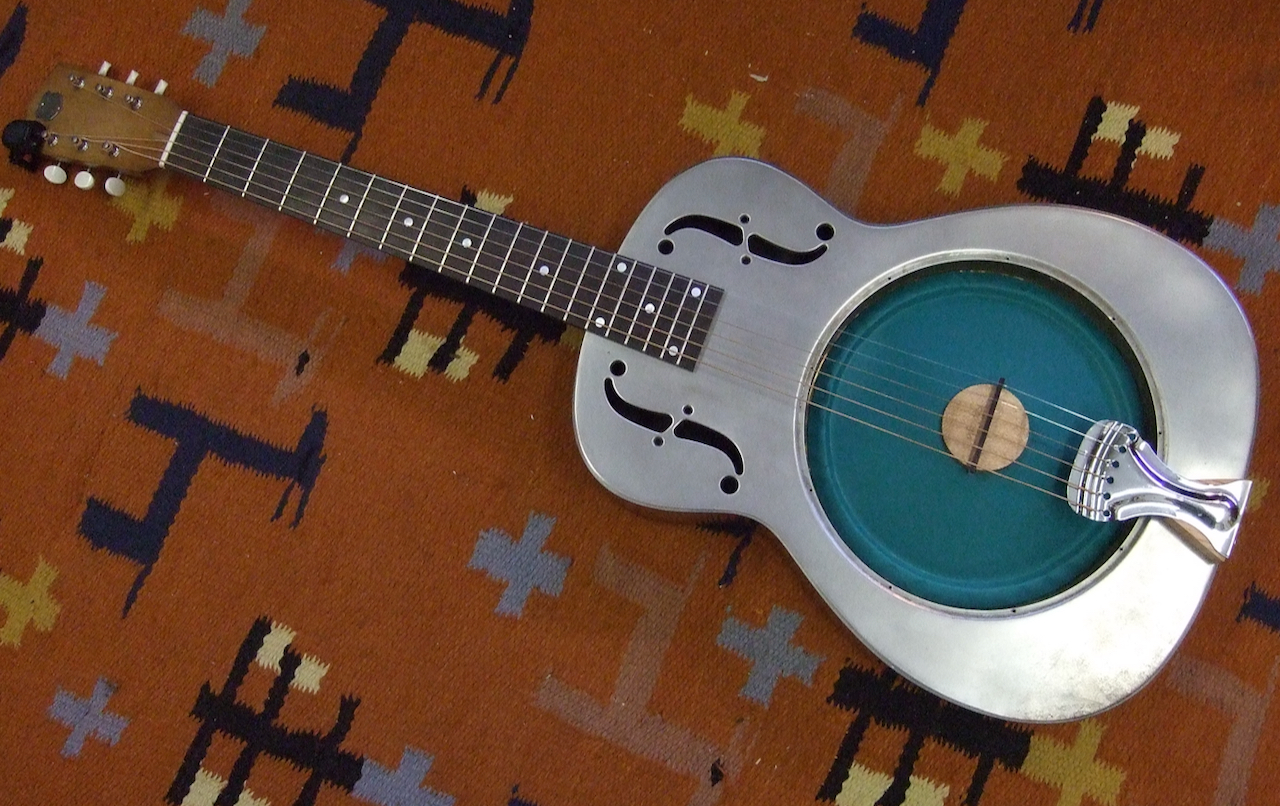
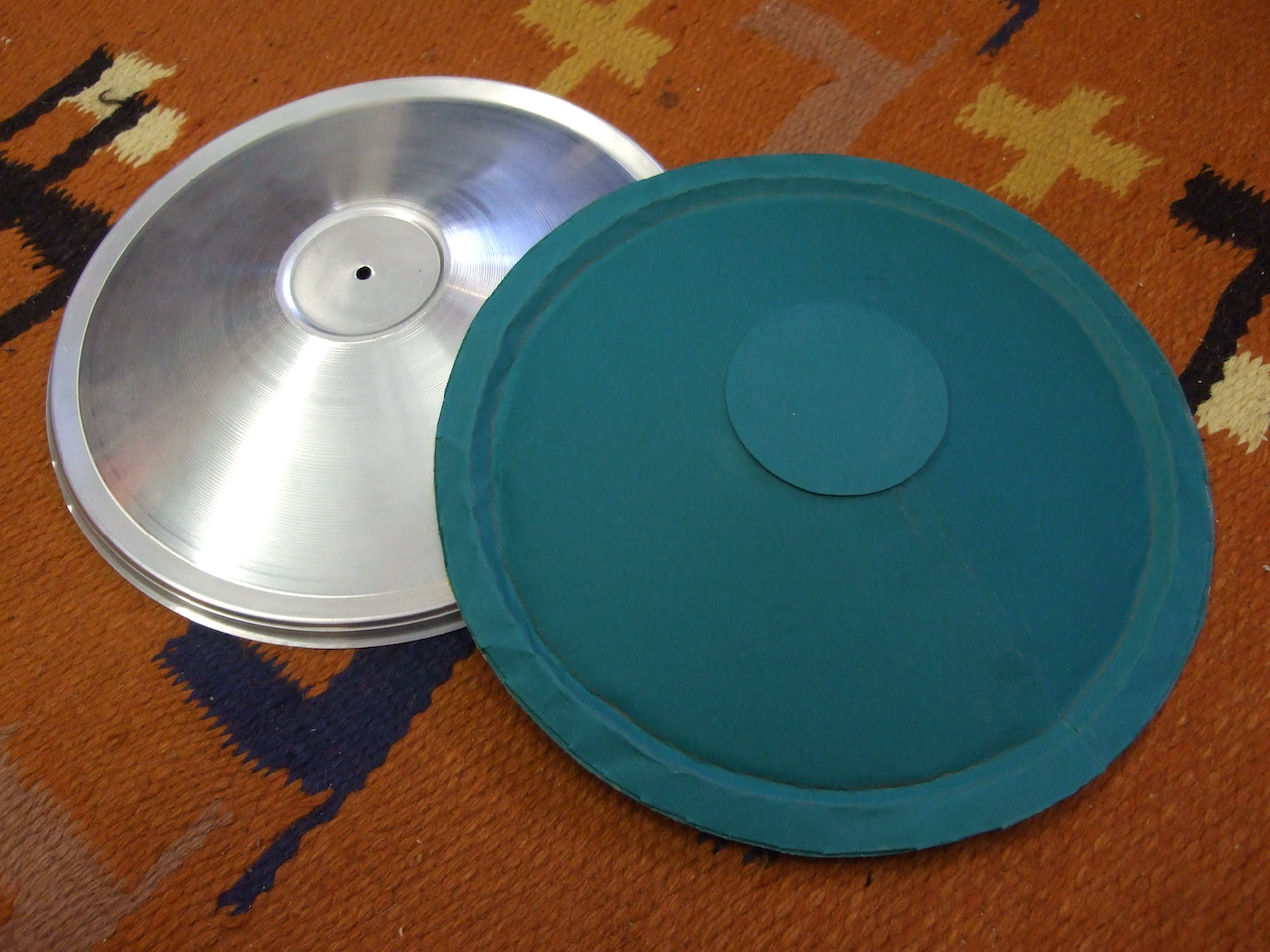 Prompted by some success at understanding how some drumhead physics can account for the biggest differences in sound between banjos and guitars, I thought I'd take on resonator guitars. At this point, I believe that the only important thing about the resonator cones themselves is that they're relatively light and rigid in the lowest relevant frequency range. The rigidity is provided by the conical shape. Links to my earlier relevant work are in ref. 1 of this new write-up:
Prompted by some success at understanding how some drumhead physics can account for the biggest differences in sound between banjos and guitars, I thought I'd take on resonator guitars. At this point, I believe that the only important thing about the resonator cones themselves is that they're relatively light and rigid in the lowest relevant frequency range. The rigidity is provided by the conical shape. Links to my earlier relevant work are in ref. 1 of this new write-up:
Resonator Guitar Physics Clue from a Paper Cone
It appears that the biggest difference in timbre between resonator and flat-top guitars is something the resonators do share with banjos. Of course, they are also loud (for an obvious, similar reason), but their overall sound is certainly guitar and not banjo.
There are sound files, identification challenges, and graphics, even if reading is not your cup of tea. (There are no equations!)
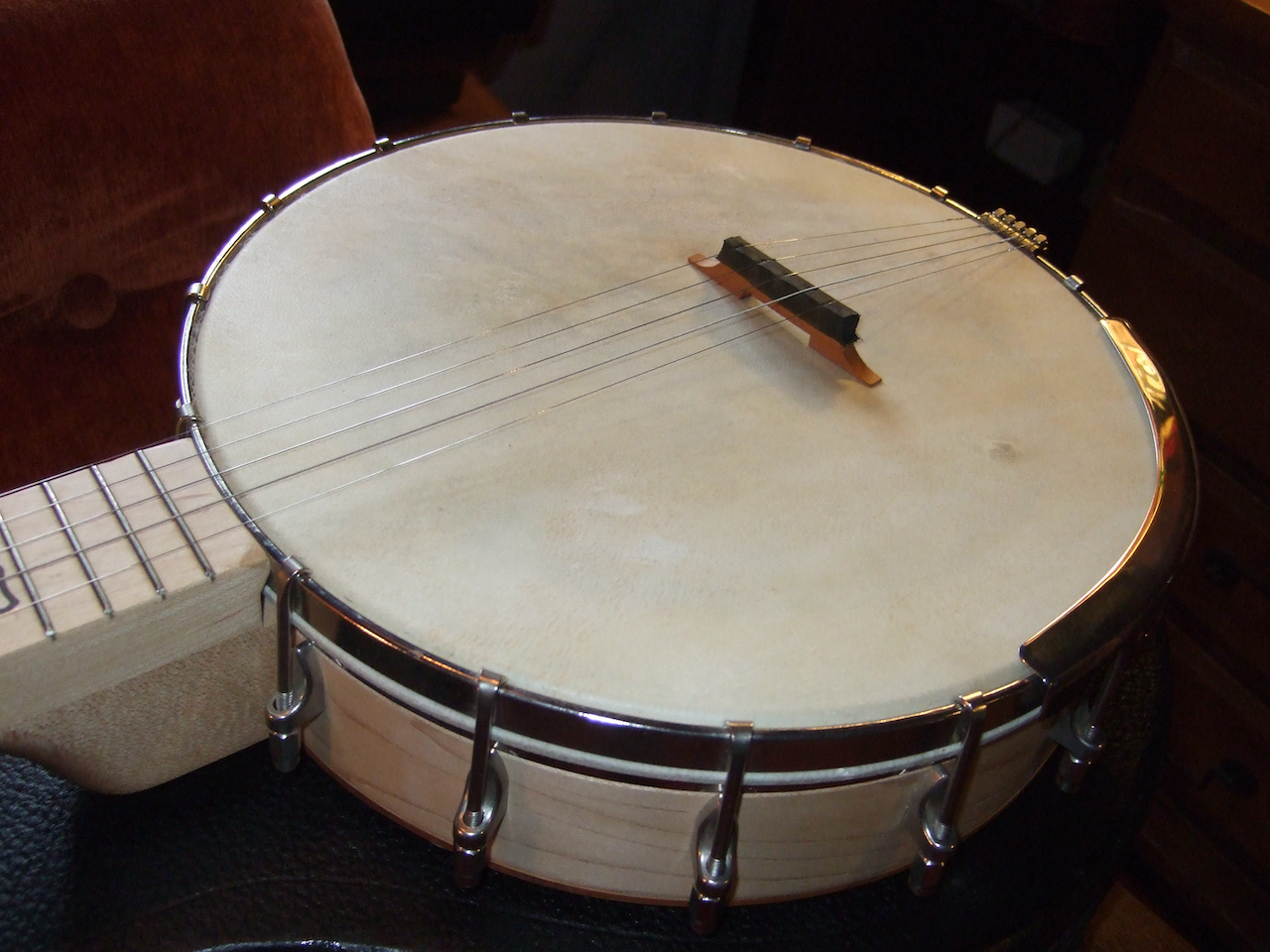
Rubber Banjo Bridge Demo describes a rubber-topped banjo bridge and provides a comparison of its sound to a standard one.
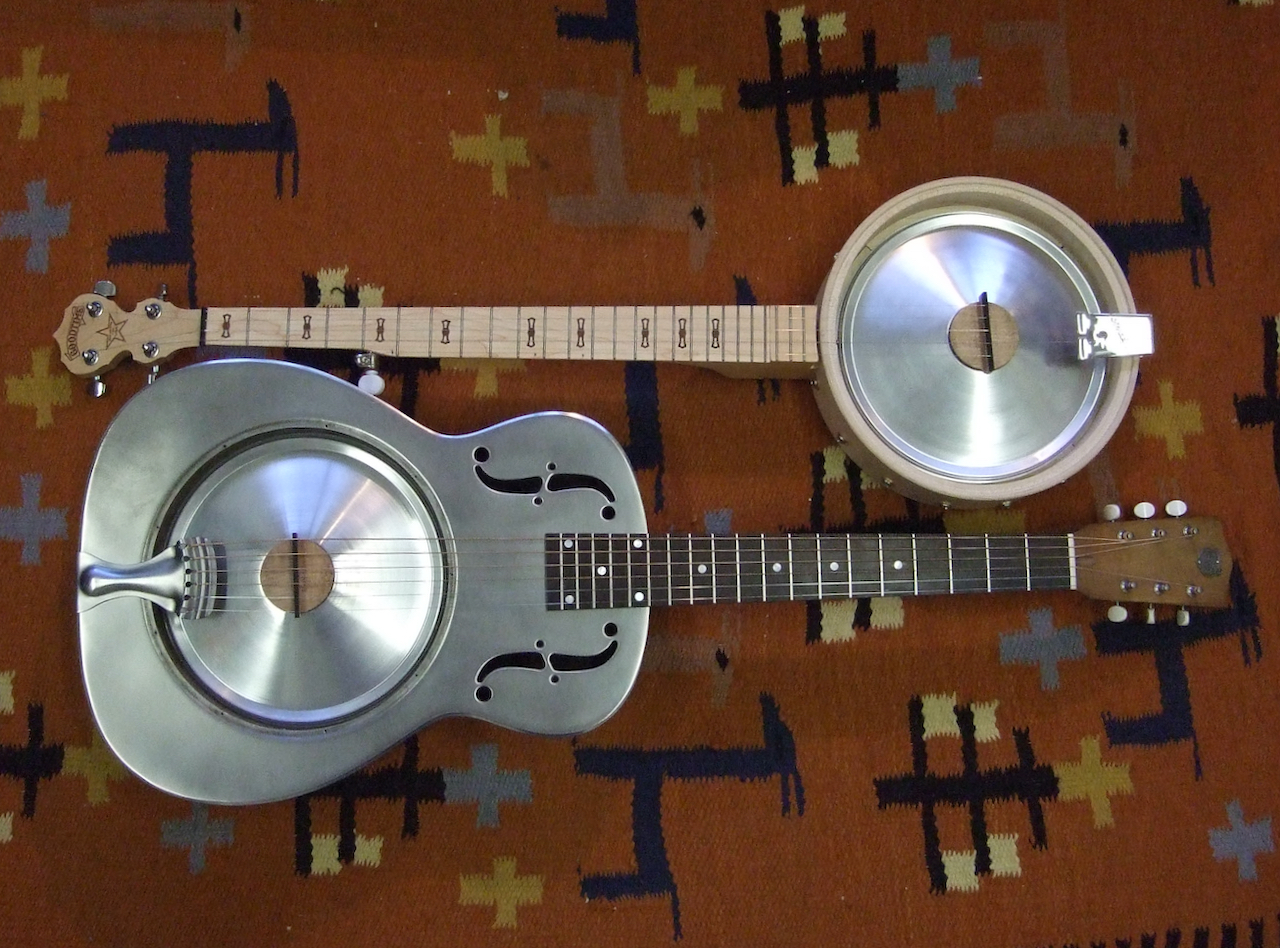
In banjos and "normal" wood-topped acoustic guitars, strings drive vibrations in the top soundboard, and those directly produce most of the sound we hear. Resonator guitars sound different because they are different. Strings drive motion of the resonator cone, which moves a lot because it is light and has relatively little internal damping. But most of the sound we hear results from the body processing the sound that comes off the back or interior side of the cone. This design is familiar to builders and tinkerers, but might not be obvious to listeners or even all players.
This note presents recording and their analyses that compare an instrument with the cone without the guitar body, a resonator guitar with the cone cover grill removed, and a standard, assembled resonator guitar. The comparisons also include a banjo and a wood-topped acoustic guitar.
An Investigation of Resonator Guitar Sound
(That file is 12MB. If fewer bites would work better for you, a version with some of the photos and other graphics in black and white or a lower resolution is available as a 4MB file: reduced graphics version of An Investigation of Resonator Guitar Sound)
Hints of the crucial differences of the the sounds of the five compared instruments involve careful single plucks and measurements of "admittance" (the motion of the bridge in response to an applied force. For orientation, I suggest a listen to a music selection played on all five. The loudnesses of the instruments are inherently very different. However, the volumes of each in this particular sample have been adjusted to be comparable -- to allow a focus on timbre.
The five instruments are in the following order: banjo, resonator cone mounter in a banjo rim, resonator guitar without the cone covering grill, complete resonator guitar, and wood-topped guitar:
five instruments played and recorded similarly.
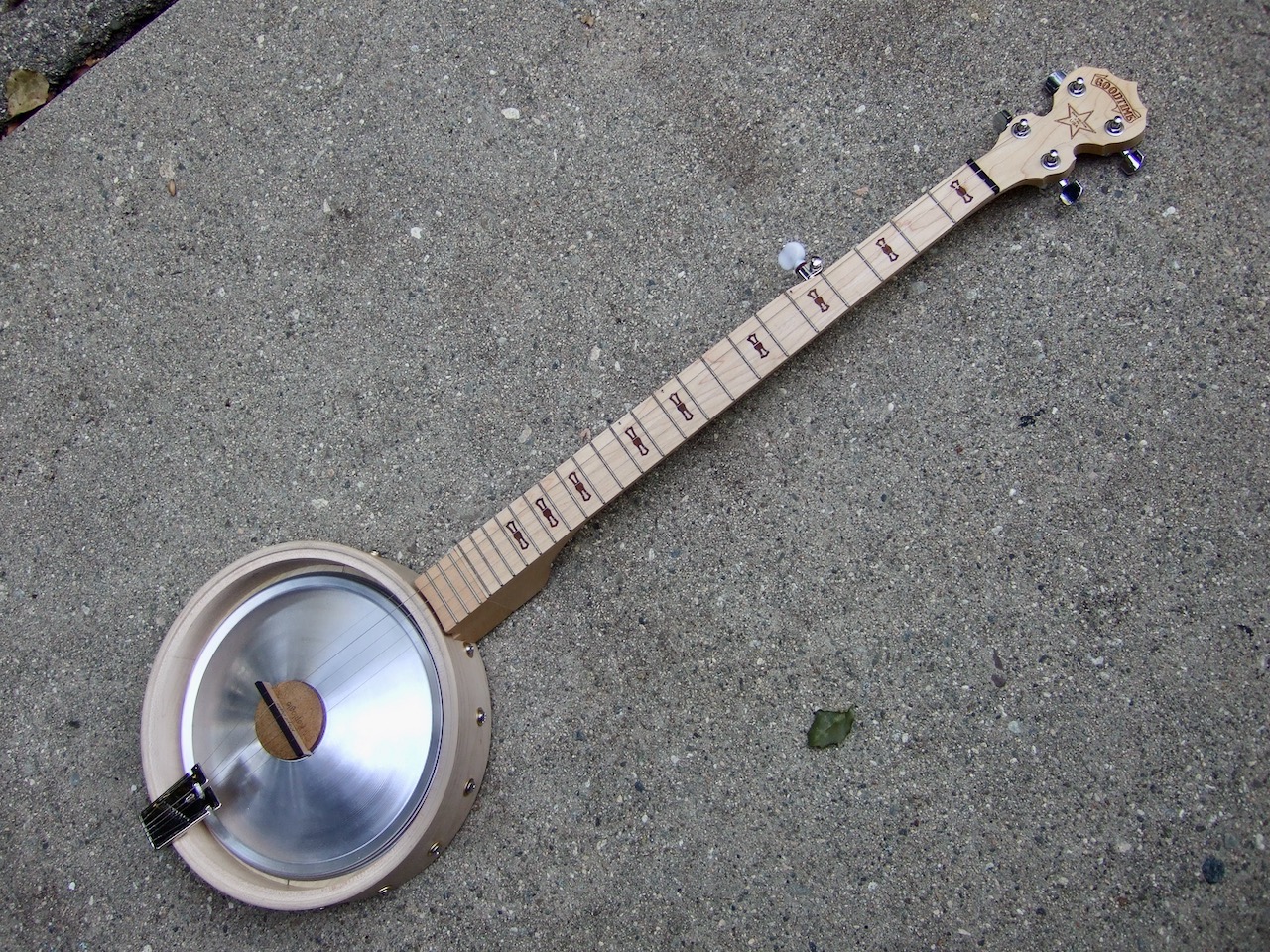 Fred Bacon played a resonator. (That's 1.) Earl played one. (That's 2.) This one has a resonator guitar cone instead of a drumhead. (As with wood-topped banjos, there's no sense in arguing over semantics.)
Fred Bacon played a resonator. (That's 1.) Earl played one. (That's 2.) This one has a resonator guitar cone instead of a drumhead. (As with wood-topped banjos, there's no sense in arguing over semantics.)
Many folks have attached 5-string necks to resonator guitar-like bodies of various shapes (-- Bill Rickard most recently and spectacularly). I'm not interested in a better or different banjo. My real interest is resonator guitars. However, they get sound from two sources: 1) directly off the top of the cone and 2) from the cone back exciting the inside of the box which produces sound out the sound holes and off the top of the box. The latter are REALLY STRONG. I want to study #1 first, on its own. That's the point of this contraption.
The sound? Here're four samples: Resonator Guitar: Banjo-like Preliminary Plan The links are on page 3. Like any banjo, the bridge makes big differences. The photos show a standard guitar "biscuit" and bridge, made by the cone spinner, Mike Replogle. And I have a lighter one, made of a typical three-foot bridge on a 3mm, 5-ply birch disk, which is closer to normal banjos. The biscuit-bridge combos are 14 gm and 9 gm, respectively.
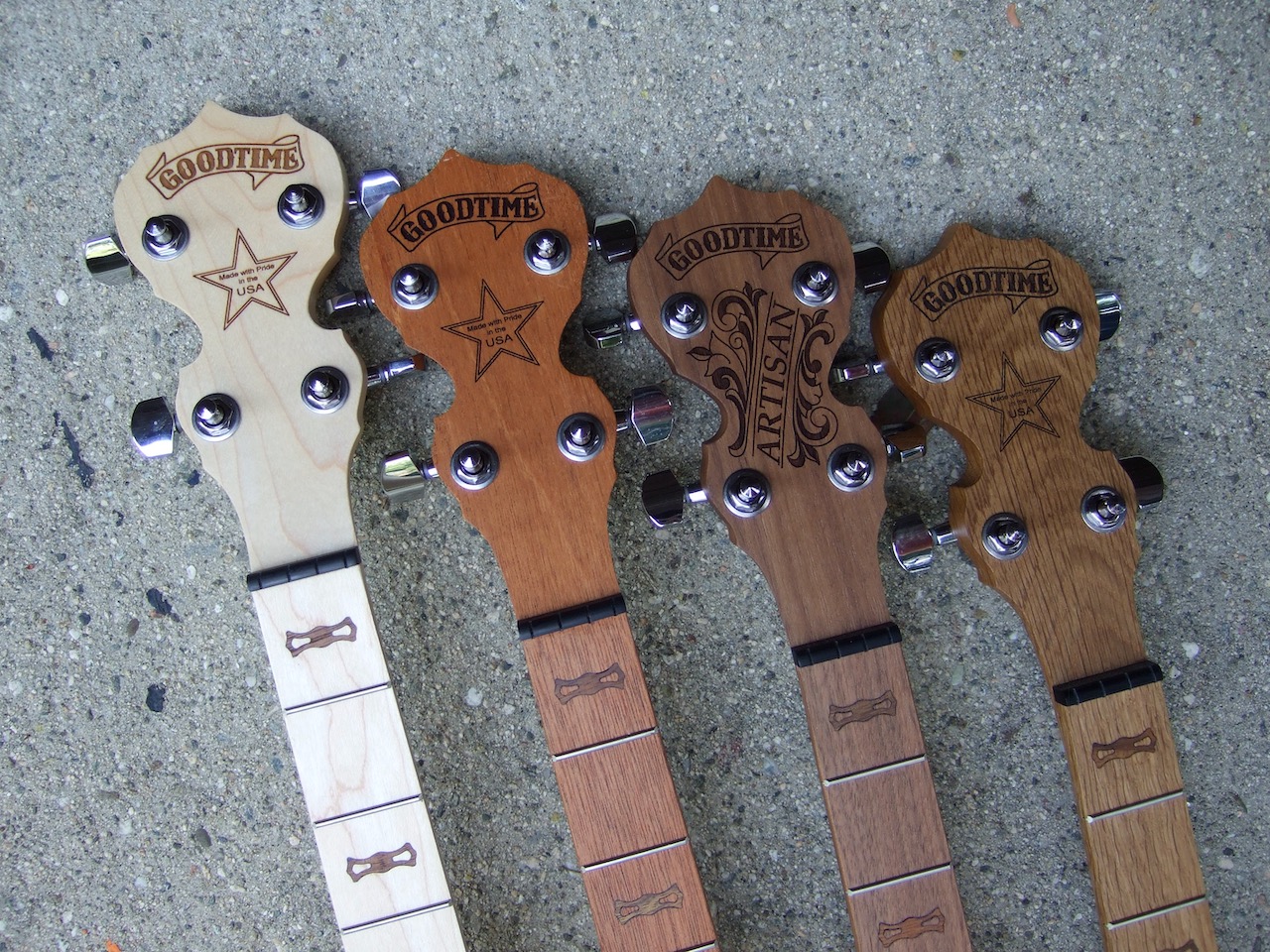 I negotiated identical CNC neck milling of four different kinds of wood. I mounted them on the same pot, with the same set-up, and recorded the sound. The sounds of played music selections and single plucks are in Four Banjo Necks and One Pot. There are also graphs of a variety of computer analyses of the pluck sounds. The write-up contains no physics because it's just too complicated. Everyone will have their own opinions and conclusions -- to which they are entitled.
I negotiated identical CNC neck milling of four different kinds of wood. I mounted them on the same pot, with the same set-up, and recorded the sound. The sounds of played music selections and single plucks are in Four Banjo Necks and One Pot. There are also graphs of a variety of computer analyses of the pluck sounds. The write-up contains no physics because it's just too complicated. Everyone will have their own opinions and conclusions -- to which they are entitled.
The music files include ones labeled by wood type and others that are unlabeled. That offers opportunities to test whether you can hear differences and whether you can distinguish which is which.
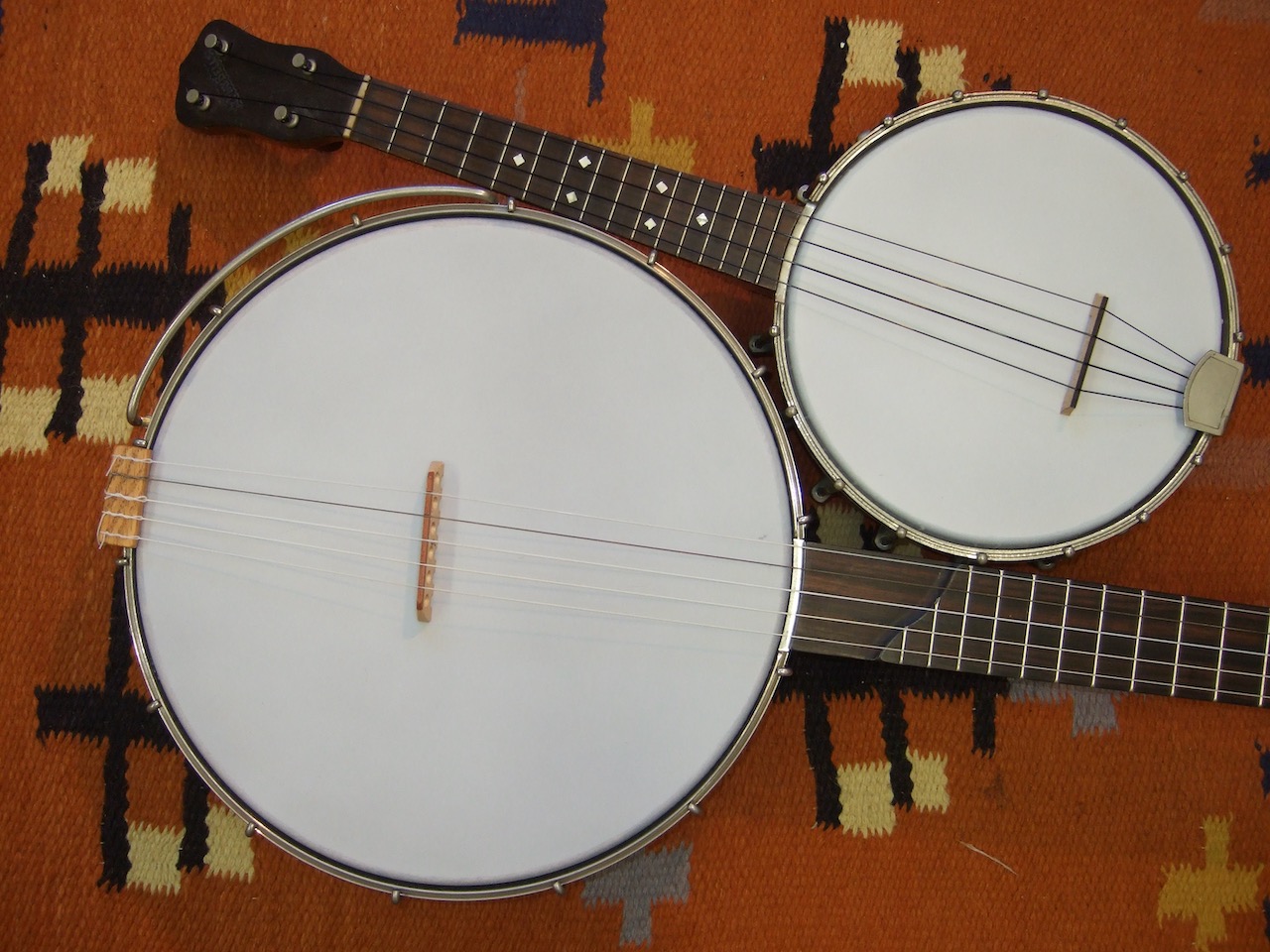
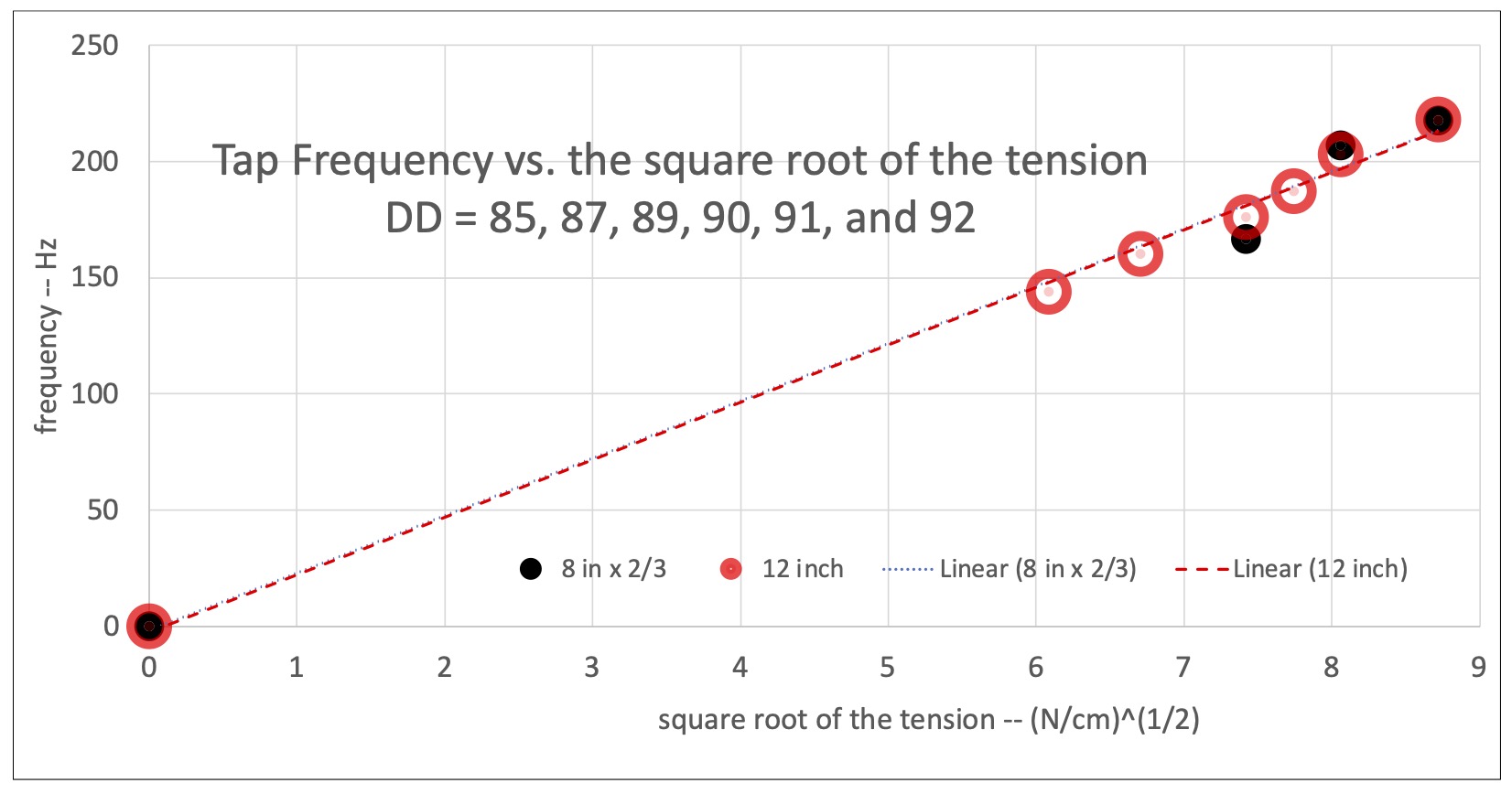 In Comments on Banjo Head Tapping, Tuning, and Tension, I expand on the investigation and description of head taps given in the appendix of The Pickers' Guide... (April 2021). It's all about whispering gallery modes. I find the comparison of measurements and theory quite convincing. There are lots of graphs and figures but no differential equations in the text. It won't make anyone a better picker or head tuner, although there is some comfort offered for folks who just can't do it.
In Comments on Banjo Head Tapping, Tuning, and Tension, I expand on the investigation and description of head taps given in the appendix of The Pickers' Guide... (April 2021). It's all about whispering gallery modes. I find the comparison of measurements and theory quite convincing. There are lots of graphs and figures but no differential equations in the text. It won't make anyone a better picker or head tuner, although there is some comfort offered for folks who just can't do it.
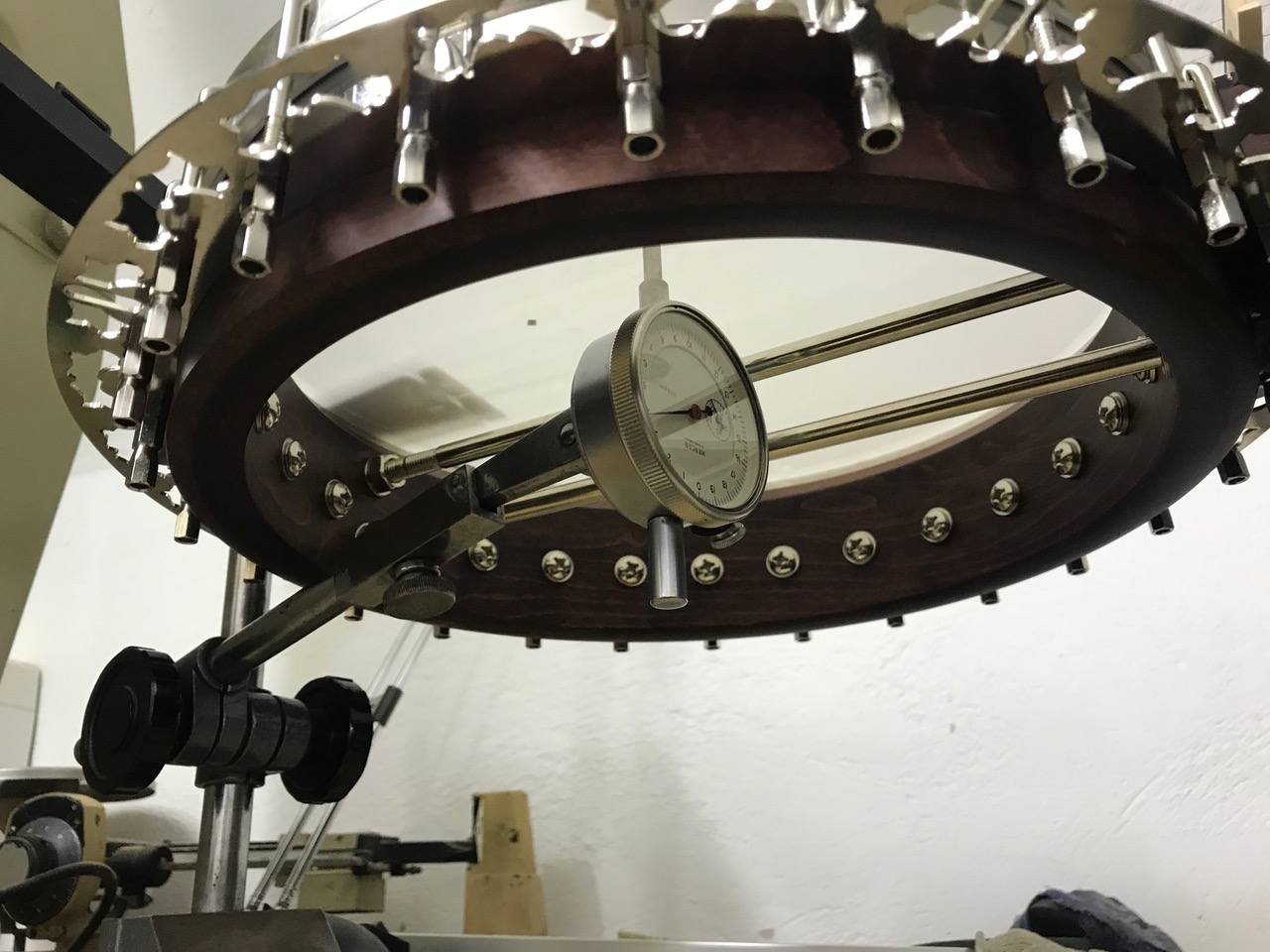 The open-access journal Acta Acustica now features a professional discussion of the basic acoustics and physics of the banjo (and all its drum-headed soundboard cousins). See https://acta-acustica.edpsciences.org/articles/aacus/full_html/2021/01/aacus200055/aacus200055.html and https://acta-acustica.edpsciences.org/articles/aacus/full_html/2021/01/aacus200052/aacus200052.html
The open-access journal Acta Acustica now features a professional discussion of the basic acoustics and physics of the banjo (and all its drum-headed soundboard cousins). See https://acta-acustica.edpsciences.org/articles/aacus/full_html/2021/01/aacus200055/aacus200055.html and https://acta-acustica.edpsciences.org/articles/aacus/full_html/2021/01/aacus200052/aacus200052.html
The Pickers' Guide... is a far shorter and less technical description of the basic measurements and physics.
 An outstanding bridge builder, Bart Veerman, asked, "How many bridges did you measure?" "Just one," I replied. If you buy the physics and numerical calculations presented in the Pickers' Guide and the Acta Acustica papers, the consequences for bridges, in general, are clear. All bridges with the same height and weight on a particular banjo will perform identically up to 2000 Hz. The sound production above that will depend on the bridge's flexing characteristics. Calculating those in advance would require sophisticated numerical finite-element modeling of the bridge and, importantly, its interaction with the head. (That's precisely what was done for the one bridge.)
An outstanding bridge builder, Bart Veerman, asked, "How many bridges did you measure?" "Just one," I replied. If you buy the physics and numerical calculations presented in the Pickers' Guide and the Acta Acustica papers, the consequences for bridges, in general, are clear. All bridges with the same height and weight on a particular banjo will perform identically up to 2000 Hz. The sound production above that will depend on the bridge's flexing characteristics. Calculating those in advance would require sophisticated numerical finite-element modeling of the bridge and, importantly, its interaction with the head. (That's precisely what was done for the one bridge.)
A simple demonstration is presented in High Frequency Formants from Banjo Bridge Design. Eight bridges of the same height, weight, and wood species but very different design (and grain) are contrasted. Each produces its own characteristic regions of stronger and weaker coupling of the strings to the head (and, therefore, to the sound). Because the interaction of bridge flexing with the head is crucial above 2000 Hz, a given bridge will sound different on different heads (and banjos) -- all in accord with players' common experience.
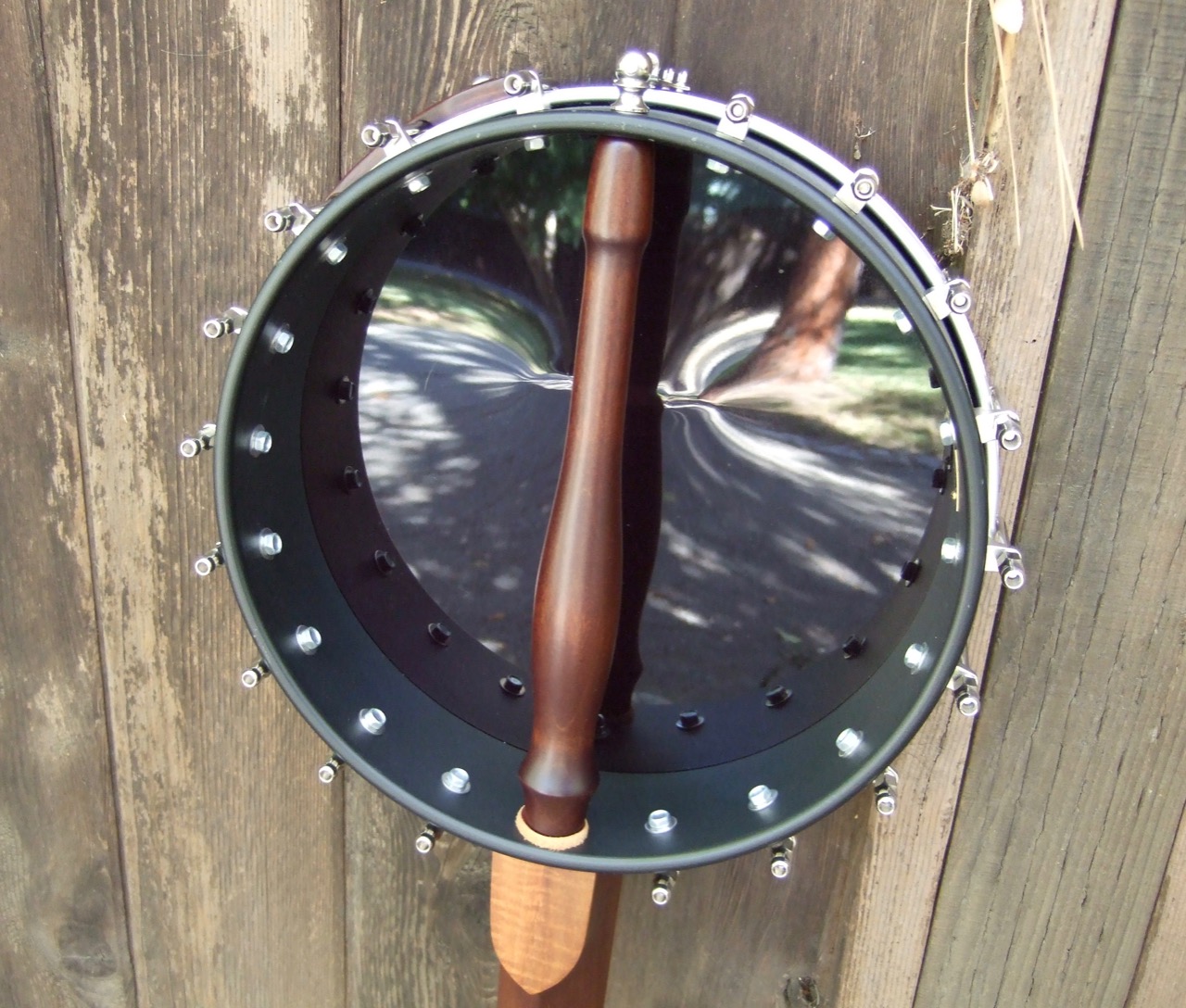 The main formant of the banjo gets its spring from the break angle. The strings and head work together on this. In fact, the head contribution is the bigger of the two. Arithmetic of Spring Forces on the Banjo Bridge offers a simplified calculation. However, the details, especially as related to the head, are monumentally geeky. They involve logarithms, Hankel functions, Taylor expansions, stress, strain, and Young's moduli.
The main formant of the banjo gets its spring from the break angle. The strings and head work together on this. In fact, the head contribution is the bigger of the two. Arithmetic of Spring Forces on the Banjo Bridge offers a simplified calculation. However, the details, especially as related to the head, are monumentally geeky. They involve logarithms, Hankel functions, Taylor expansions, stress, strain, and Young's moduli.
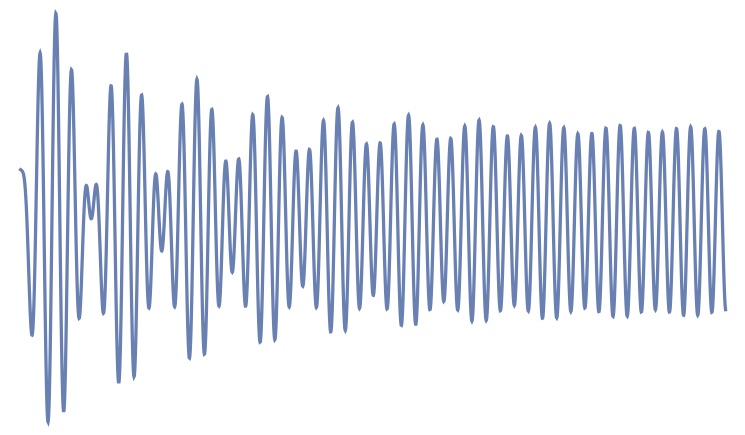 An Elementary Account of Plucked String Clonk gives an instructive example from elementary linear differential equations that illuminates how the sudden onset of a string pluck produces all manner of sounds that come from banging on the instrument body and are only remotely related to the pitch of the string. These play a very important role in banjo sound because they are loud and persist for much of the time between notes.
An Elementary Account of Plucked String Clonk gives an instructive example from elementary linear differential equations that illuminates how the sudden onset of a string pluck produces all manner of sounds that come from banging on the instrument body and are only remotely related to the pitch of the string. These play a very important role in banjo sound because they are loud and persist for much of the time between notes.
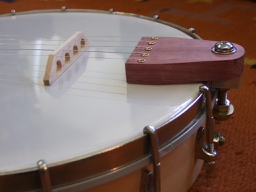 Banjo Break Angle Tension Modulation as Parametric Oscillation corrects the suggestion made in APRIL 2014 regarding the impact of bridge motion on banjo timbre. This time I do the math rather than jumping prematurely to the conclusion. The practical, qualitative consequence in terms of sound is unchanged, but it's always worth getting the math and physics right.
Links to the relevant sound files are in included in the write-up; they also appear below at MARCH 2019.
Banjo Break Angle Tension Modulation as Parametric Oscillation corrects the suggestion made in APRIL 2014 regarding the impact of bridge motion on banjo timbre. This time I do the math rather than jumping prematurely to the conclusion. The practical, qualitative consequence in terms of sound is unchanged, but it's always worth getting the math and physics right.
Links to the relevant sound files are in included in the write-up; they also appear below at MARCH 2019.
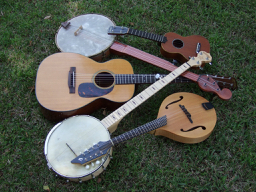 String Sing Along (Sympathetic Vibration) Is Not the Key to Banjo Sound is a description of a null experiment. Banjo strings "sing along" with whatever you play -- and much more so than on other string instruments. Is this an important part of what characterizes banjo sound? I devised a listening experimnent, and it convinced me that the answer is no.
String Sing Along (Sympathetic Vibration) Is Not the Key to Banjo Sound is a description of a null experiment. Banjo strings "sing along" with whatever you play -- and much more so than on other string instruments. Is this an important part of what characterizes banjo sound? I devised a listening experimnent, and it convinced me that the answer is no.
Below are single note sample synthesis versions of a very short phrase. In one case, the single notes are the sound of a plucked string with all other strings damped. The other case is constructed from single note samples where all strings are left free to vibrate:
They're funky and not identical but both distinctly banjo-like, with neither particularly more so.
The details are discussed in the linked write-up, including demonstrations and explanations of when sympathetic vibrations are most dramatic and why they're such minor effects in normal playing.
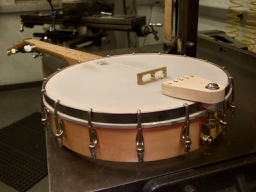
One banjo, two tunes, two set-ups -- If you can't hear the difference, then what follows is a waste of time (although you might first consider turning up the volume, connecting slightly better speakers, or putting in your hearing aids):
A.mp3 , B.mp3 , C.mp3 , D.mp3 .
Banjo Ring from Stretching String: A Zero Break Angle Demo compares the sound of zero break angle to 13 degrees. This provides further evidence for the idea, presented in APRIL 2014, below, that break angle provides the ring of the banjo -- or at least a lot of it. Listen for yourself -- and maybe read. (This is a revised manuscript, dated 3/7/20, which includes mention of the Karplus-Strong algorithm for plucked-string sound synthesis.)
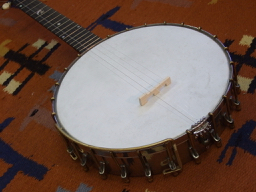 Extra Extra Light Steel Strings on Old Banjos was prompted by the concern that the higher tension of steel strings can damage vintage instruments that were designed for gut and silk strings. Perhaps the most useful part of the note are the links to sound files (on p. 3) that compare commonly available nylon strings, steel strings so thin that they have about the same tension, yet thinner nylon strings, and slightly heavier ("extra light") steel strings. The text discusses how to estimate tensions but offers no assurances regarding the safety of your old banjo.
Extra Extra Light Steel Strings on Old Banjos was prompted by the concern that the higher tension of steel strings can damage vintage instruments that were designed for gut and silk strings. Perhaps the most useful part of the note are the links to sound files (on p. 3) that compare commonly available nylon strings, steel strings so thin that they have about the same tension, yet thinner nylon strings, and slightly heavier ("extra light") steel strings. The text discusses how to estimate tensions but offers no assurances regarding the safety of your old banjo.
A Banjo Pickup Alternative AND Trying to Understand Pickup Feedback and Tone -- a fool's errand offers a $30 to $50 pickup that might be good enough: a suitably mounted guitar rare earth soundhole pickup.
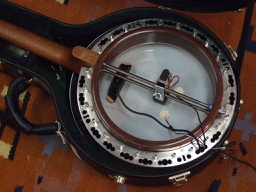 Open the text, and you'll find links to sound samples of the popular Fishman banjo pickup and a dirt cheap piezo disk pickup as well as the suggested sound hole pickup. An effort is made to quantify the degree of feedback. The sound hole pickup does about as well as the Fishman, at least in terms of feedback. (The $200 Fishman includes some serious multichannel equalization.)
Open the text, and you'll find links to sound samples of the popular Fishman banjo pickup and a dirt cheap piezo disk pickup as well as the suggested sound hole pickup. An effort is made to quantify the degree of feedback. The sound hole pickup does about as well as the Fishman, at least in terms of feedback. (The $200 Fishman includes some serious multichannel equalization.)
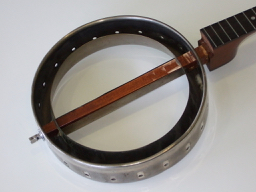 The Original Internal Resonator Banjo: the Dobson Great Echo makes the case that the original internal resonator banjo was not Fred Bacon's ff Professional (1906 patent) but actually C. E. Dobson's Great Echo, patented in 1888. It's likely that thousands of Great Echoes were produced in the ensuing twenty years. Surviving examples are rare but not unheard of. The write-up is about history and not physics. (There are no formulas.) And it includes a couple of sound samples.
The Original Internal Resonator Banjo: the Dobson Great Echo makes the case that the original internal resonator banjo was not Fred Bacon's ff Professional (1906 patent) but actually C. E. Dobson's Great Echo, patented in 1888. It's likely that thousands of Great Echoes were produced in the ensuing twenty years. Surviving examples are rare but not unheard of. The write-up is about history and not physics. (There are no formulas.) And it includes a couple of sound samples.
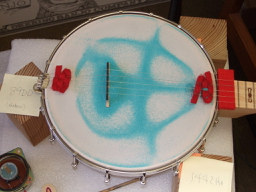 I tried to find measurements to substantiate my suggestions of how to understand how the air inside the pot impacts the produced sound. It didn't work out the way I had hoped, but lots happened along the way.
I tried to find measurements to substantiate my suggestions of how to understand how the air inside the pot impacts the produced sound. It didn't work out the way I had hoped, but lots happened along the way.
Banjo Drum Physics -- sound experiments and simple acoustics demos describes some of that. It's long but has attemps at explanations rather than any equations.
Here is a sound sample of sound sample of the extreme versions of the banjos used, i.e., 2" and 5 5/8" rims with tensions 85 and 91 on a DrumDial.
And here is the sound of taps across the center of a head, from one side to the other, which is related to why the center of the head is not an ideal place for the bridge.
 Whither Tone Ring Ring? presents a simple picture and simple substantiating measurements of how the tap sounds of tone ring and wood rim separately determine the sound of their combined system.
Whither Tone Ring Ring? presents a simple picture and simple substantiating measurements of how the tap sounds of tone ring and wood rim separately determine the sound of their combined system.
Here is a sound sample of tone ring, wood rim, and combined system -- one tap each (Listen to the end!)
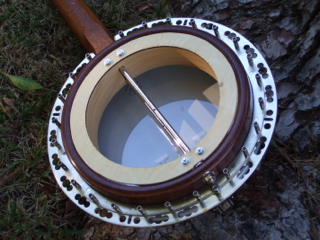 Resonator-Resonator Banjo is subtitled: an adventure in amateur lutherie and a lesson in musical acoustics. I put an internal resonator into a resonator banjo just to hear what it would sound like. You can, too.
Read (4 pages, pictures, no equations) or just listen:
Resonator-Resonator Banjo is subtitled: an adventure in amateur lutherie and a lesson in musical acoustics. I put an internal resonator into a resonator banjo just to hear what it would sound like. You can, too.
Read (4 pages, pictures, no equations) or just listen:
with the internal resonator installed
and the latter with a much lighter bridge.
Banjo Drum Physics -- theoretical preliminaries is 30-plus pages thick with differential equations, Fourier series, and complex numbers (but no sound files). It is, of course, aimed at helping understand how banjos work. In particular, it presents the simplest way I could figure out to do the physics of the effect of the air inside the pot on the produced sound -- via its interaction with the head.
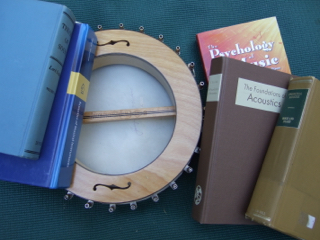 The goal is to gain some overall perspective. Correct, formal solutions of the equations have been known for over a hundred years, but to figure out what they're telling me, particularly as relates to the banjo, required a simpler approach than any I'd found in the literature.
The goal is to gain some overall perspective. Correct, formal solutions of the equations have been known for over a hundred years, but to figure out what they're telling me, particularly as relates to the banjo, required a simpler approach than any I'd found in the literature.
DYI Mylar Flange for a More Mellow Banjo Head describes how you can cut a second mylar head and install it under your regular head to reduce some of the sharpest "ping" sounds --- fast, inexpensive, and totally reversible.
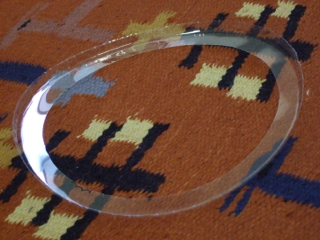 Here are the sounds of head taps before and after. For links to actual plucked strings (and instructions), click here for the write-up.
Here are the sounds of head taps before and after. For links to actual plucked strings (and instructions), click here for the write-up.
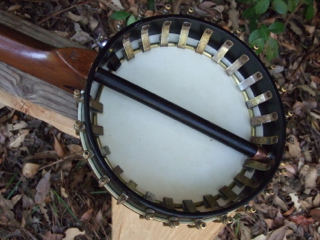 A Hoseus Banjo Restoration describes some simple, amateur efforts to bring a bottom-of-the-line 19th Century banjo back to life. It features an 1886 patented head support system that never really caught on. There's no physics, just banjo tomfoolery.
A Hoseus Banjo Restoration describes some simple, amateur efforts to bring a bottom-of-the-line 19th Century banjo back to life. It features an 1886 patented head support system that never really caught on. There's no physics, just banjo tomfoolery.
The accompanying sound files (also linked in the pdf) are: ("steel" refers to steel strings and a 2 oz. bridge; "fish" refers to fishing line strings and a 1 oz. bridge)
The same supported-ring head system was patented in 1903 by W. Farmer -- https://patents.google.com/patent/US724833A/en. (A patent duplication of a significant design innovation is described in the August 2018 entry on this page.)
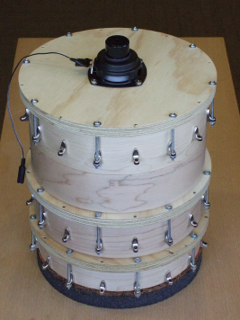 Banjo Rim Height and Sound in the Pot is a follow-up to the first endeavor in this banjo physics series. (See DECEMBER 2013, below.) That study focused on the two lowest frequency modes. The totally new material here is an iquiry into the effect of rim height on the whole spectrum. Measurements on the three different height rims bear out the standard calculation of sound resonances inside cylindrical containers. While this might not sound too impressive, just looking at the results tells you something very significant about the role of rim height in the transformation of string pluck to radiated sound. For the acousticians of musical instruments, a careful repeat of the 2013 measurements establishes a stark contrast between the banjo and the guitar (an other wood-topped instruments) regarding the Helmholtz resonance.
Banjo Rim Height and Sound in the Pot is a follow-up to the first endeavor in this banjo physics series. (See DECEMBER 2013, below.) That study focused on the two lowest frequency modes. The totally new material here is an iquiry into the effect of rim height on the whole spectrum. Measurements on the three different height rims bear out the standard calculation of sound resonances inside cylindrical containers. While this might not sound too impressive, just looking at the results tells you something very significant about the role of rim height in the transformation of string pluck to radiated sound. For the acousticians of musical instruments, a careful repeat of the 2013 measurements establishes a stark contrast between the banjo and the guitar (an other wood-topped instruments) regarding the Helmholtz resonance.
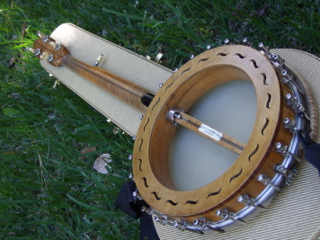 A variety of acoustics experiments are presented in Physics of the Bacon Internal Resonator Banjo in an effort to capture what is going on inside the pot, its relation to the design, and its effect on the sound. The right experiments coupled with some simple ideas yield a fair number of qualitative and quantitative insights.
A variety of acoustics experiments are presented in Physics of the Bacon Internal Resonator Banjo in an effort to capture what is going on inside the pot, its relation to the design, and its effect on the sound. The right experiments coupled with some simple ideas yield a fair number of qualitative and quantitative insights.
(That's an 8 MB file. If you're going to print it out on a B-and-W printer, here is a 6 MB version, already in grey-scale.)
Three sound files are linked in the write-up but are also available here:
Note added 4/21/18 -- a precusor!: Nearly 20 years before Bacon, C. Edgar Dobson started selling his "Great Echo Banjo." At the bottom of its brass rim, it bent inward and upward, coming to within about a 1/2" of the under side of the head. That formed an 1" wide annulus, i.e., an internal resonator. (Patent linked here.) The basic physics and consequent sound are the same as described here. (I've got my eye out for one; they're rare.)
(8/2/16: The discussion of FIG. 14 misidentifies which pot is which. If you're serious, you can get it right; you've just got to picture the actual pot geometries. Why didn't I fix it? This same manuscript is in two other "permanent" archives. It's hard to say whether it's worth messing with them.)
Air modes of the Bacon internal resonator banjo is a terser, more "professional" write up of the same investigation (14 pages of text versus 22 -- but you'd miss some great photos). It was summarily rejected by the Journal of the Acoustical Society of America. Apparently, "the conclusions are very weak and simple." It was faulted for not explicitly referencing relevant previous work. However, the only relevant previous work is over 150 years old and a standard part of the sophomore physics curriculum where I work. There also is no section titled "Methods," as well as other violations of the Scientific Method as articulated by Francis Bacon (perhaps no relation) in the 16th Century and taught to STEM junior high students everywhere.
 There are sound files linked in the write-up, but I include the first one here as a teaser. What you hear are the taps of a piano hammer on four Deering Goodtime pots, tapping from center to rim. The pots, in order, are 1) an old wood rim, 2) an old wood rim fitted with a 1/4" diameter brass ring, 3) a new wood rim, and 4) a new wood rim fitted with a Bacon tone ring.
There are sound files linked in the write-up, but I include the first one here as a teaser. What you hear are the taps of a piano hammer on four Deering Goodtime pots, tapping from center to rim. The pots, in order, are 1) an old wood rim, 2) an old wood rim fitted with a 1/4" diameter brass ring, 3) a new wood rim, and 4) a new wood rim fitted with a Bacon tone ring.
I found the differences to be noteworthy and something of a challenge to explain. The write-up is long but has no equations. It also has no triumphal confirmation of theory by experiment, but I believe that the suggested perspectives are enlightening in this context and more broadly.
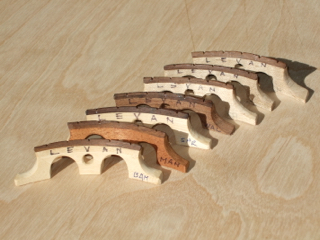
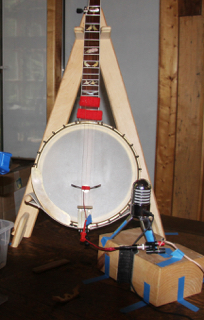
Banjo Bridge Wood Comparisons compares bridges made of different kinds of wood. (!) Together with luthier/designer Ken LeVan, we compared bridges of the same design and weight but very different species, i.e., bamboo versus mahogany and spruce versus walnut. As judged by spectral analysis, the differences were discernable but very slight.
You can listen to sound files of actual playing with those bridges on the same banjo here, in this directory. The bridges are identified there only by number. You can and should do a "blind" listening test and only consult the Banjo Bridge Wood Comparisons manuscript key (at the end of the paper) after forming your own opinions.
Design and weight certainly impact the sound. However, by matching bridges as we did, there's not much left to make a difference. The speeds of sound through the bridges may be different but are too high to matter acoustically. And the differences in hardness, which would impact flexibility, are largely compensated by the matching of weight. (I.e., the softer woods are less dense; so to make up the weight, there's more of it [in the "thickness" dimension].)
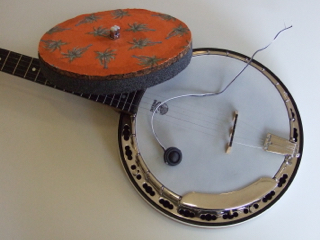
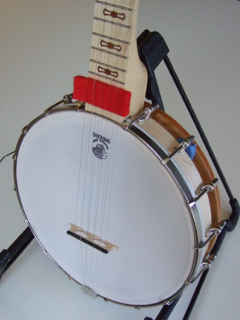 The relevant sound sample files are ppA.mp3, ppB.mp3, ppC.mp3, and ppD.mp3. Good speakers help. You'll have to read to find of what they are and which is which.
The relevant sound sample files are ppA.mp3, ppB.mp3, ppC.mp3, and ppD.mp3. Good speakers help. You'll have to read to find of what they are and which is which.
I came across a very relevant tidbit from Jim Rae. (See p. 5.) He writes, "At least 99% of a banjo's sound power occurs below 5000 Hz,..." Jim has done extensive measurements on resonator banjos, some in collaboration with Tom Rossing (e.g., see The Science of String Instruments) and some as consultant to Steve Huber in the development of the Huber "Truetone" rim and ring. That's why I initially only looked below 5000 Hz. Noting the measurements presented in FIG.s 2 and 3 in part 2:... (above), that's why overall loudness is hardly effected by the resonator but the resonator is a significant factor in tone determined by yet higher frequencies.
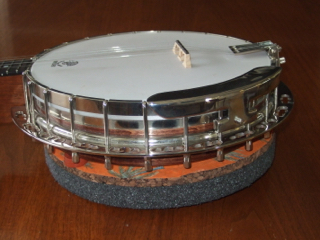 The Resonator Banjo Resonator, part 1: Overall Loudness
presents the recordings and measurements that convinced me that the resonator on a resonator banjo does not make the sound any louder. It was a surprise to me, though it may be well-known to others. I stumbled on it while trying to learn about sound holes. My modest conclusions there (and perhaps a couple of new perspectives) are described in the next item, Sound Hole Sound.
The Resonator Banjo Resonator, part 1: Overall Loudness
presents the recordings and measurements that convinced me that the resonator on a resonator banjo does not make the sound any louder. It was a surprise to me, though it may be well-known to others. I stumbled on it while trying to learn about sound holes. My modest conclusions there (and perhaps a couple of new perspectives) are described in the next item, Sound Hole Sound.
The accompanying Resonator Banjo sound file is here, as well as being linked within the article.
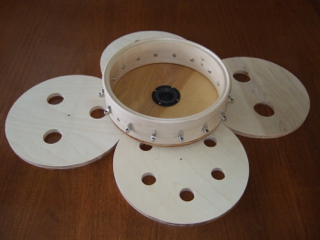 Helmholtz and Rayleigh did the classic work on the flow through a sound hole, which determines how much the hole contributes to the volume of the produced sound. In Sound Hole Sound, I describe their work and do some measurements relevant to real instruments' geometries. In particular, at least a qualitative account is given of the the effects of the side walls of the sound box and the possibility of multiple holes. In the end, this discussion has essentially no relevance to banjos (except, perhaps, to cigar box instruments).
Helmholtz and Rayleigh did the classic work on the flow through a sound hole, which determines how much the hole contributes to the volume of the produced sound. In Sound Hole Sound, I describe their work and do some measurements relevant to real instruments' geometries. In particular, at least a qualitative account is given of the the effects of the side walls of the sound box and the possibility of multiple holes. In the end, this discussion has essentially no relevance to banjos (except, perhaps, to cigar box instruments).
Also, this article is heavy on the physics (albeit fairly elementary) and very light on the music.
A couple of years ago, Jim made a wonderful documentary, The Librarian and the Banjo about a very important book, Sinful Tunes and Spirituals: Black Folk Music to the Civil War, and its amazing author, Dena Epstein. It is a major, pioneering piece of historical scholarship about an era and subjects previously largely ignored. Banjo history is really just only one small part of that story.
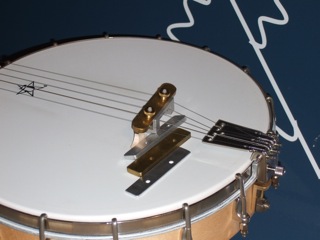 Banjo Bridge Mutes begins with a demonstration and simple explanation of how and why mutes that clamp to the bridge increase sustain and mellow the sound --- in addition to making things quieter. Not for the faint of heart is the ensuing, only partly successful attempt to make that discusion more precise and quantitative.
Banjo Bridge Mutes begins with a demonstration and simple explanation of how and why mutes that clamp to the bridge increase sustain and mellow the sound --- in addition to making things quieter. Not for the faint of heart is the ensuing, only partly successful attempt to make that discusion more precise and quantitative.
Simple Anti-Tone Rings for the Banjo: Do-it-yourself Electric, Surgical, and McGhee tone rings that can be easily and inexpensively installed to make modern banjos sound old.
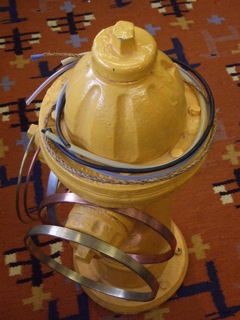
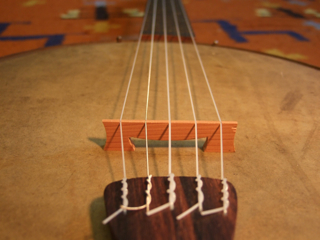 Zany strings and finicky banjo bridges explains how tiny details of the string-bridge connection dramatically effect how the strings vibrate and the sound they produce. This version is equation-free; the math details are in The plucked string: an example of non-normal dynamics, which provides an elementary introduction to the more general subject of transient growth and "non-normal" equations -- published in the American Journal of Physics, Am. J. Phys. 83, 395 (2015). (This is a slightly expanded and improved version than the original.)
Zany strings and finicky banjo bridges explains how tiny details of the string-bridge connection dramatically effect how the strings vibrate and the sound they produce. This version is equation-free; the math details are in The plucked string: an example of non-normal dynamics, which provides an elementary introduction to the more general subject of transient growth and "non-normal" equations -- published in the American Journal of Physics, Am. J. Phys. 83, 395 (2015). (This is a slightly expanded and improved version than the original.)
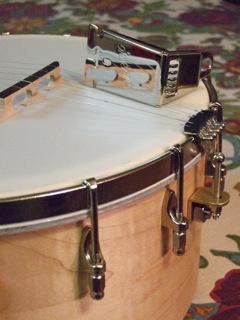
 Here is a very short version of that
same idea, Banjo timbre from string
stretching and frequency modulation, published in Acta Acustica (united with Acustica), AAuA 101(1) 1, January 2015. However, the language is
considerably more technical. It's been slightly revised since my
first posting here in response to a certain amount of professional
acoustician refereeing.
Here is a very short version of that
same idea, Banjo timbre from string
stretching and frequency modulation, published in Acta Acustica (united with Acustica), AAuA 101(1) 1, January 2015. However, the language is
considerably more technical. It's been slightly revised since my
first posting here in response to a certain amount of professional
acoustician refereeing.
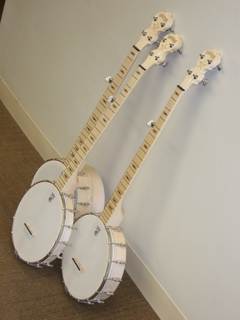 This was my first Banjo Physics project, written up in December 2013:
The Open Back of the Open-Back Banjo. There are four essential, accompanying sound files which you'll need to follow along with the manuscript. (You might want to save them on the side, to listen as you read.) They are:
This was my first Banjo Physics project, written up in December 2013:
The Open Back of the Open-Back Banjo. There are four essential, accompanying sound files which you'll need to follow along with the manuscript. (You might want to save them on the side, to listen as you read.) They are:
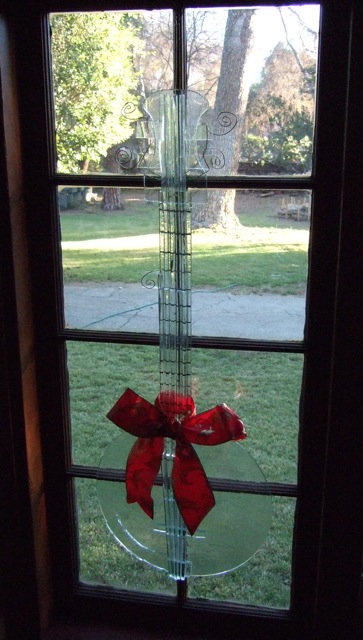
glass banjo by M. Desy; soft banjo by Sally Suzuki
